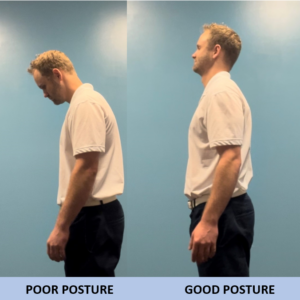Tips on Posture
Posture Matters: Tips to Improve Your Alignment and Wellbeing

May has several causes attributed to it, and one of them is “Correct Posture Month”. Posture is relevant all year-round, but what better reason than that to level up your posture?!
Posture is a key component of overall health and wellbeing; it affects breathing, digestion, mood, musculoskeletal alignment, and more. Good posture supports all these facets of health; poor posture, on the other hand, can contribute to a range of physical and mental problems, from back pain and headaches to symptoms of anxiety and depression. In this article, we will discuss common posture problems as well as solutions.
Common Posture Problems:
- Text Neck: With the use of computers and mobile devices becoming ubiquitous, text neck has become a common posture problem. Text neck is the result of holding the head forward and down while looking at a phone or other screen. This can cause strain on the neck and upper back muscles.
- Slouching: This is a common problem for people who sit for long periods of time, such as those with desk jobs. Slouching can lead to chronically forward-rounded shoulders, forward head carriage, and even hunchback (excessive forward curvature in the upper back).
- Swayback: This is another common problem for people who sit for long periods of time. This occurs when the lower back curves forward (more than the natural curvature), causing the pelvis to tilt forward (anterior pelvic tilt). This can be caused by tight hip flexors and/or weak abdominal muscles.
As technology continues to advance, and we continue to collectively spend a lot of time on our devices, it’s important to not give up hope for achieving and maintaining healthy posture. Let’s stay positive and talk about what we can do.
Solutions to Improve Posture:
- Practice good sitting posture:
- To sit with good posture, start by sticking your tailbone (coccyx, sacrum) backwards, or “untuck your tail”. This takes pressure off your tailbone and puts it more appropriately on your sitting bones (ischial tuberosities). This also makes sitting upright with better overall posture much easier.
- Sit up straight with your shoulders back and your feet flat on the ground. Avoid crossing your legs, as this can cause strain on your hips and lower back. Use an ergonomic chair and adjust the height so that your feet are flat on the ground.
- Take breaks from sitting: If you sit for long periods of time, take frequent breaks to stretch and move around. Stand up and walk around for a few minutes every hour or so to help improve circulation and reduce stiffness. A little bit can go a long way for your health!
- Make “spinal hygiene” – brief stretching/strengthening moves to combat the everyday postural stressors – a part of your regular routine (after all, you brush your teeth every day, don’t you?).
- Stretch tight muscles: Stretching tight muscles can help improve posture and reduce the risk of injury. Regularly stretch your chest, shoulders, neck, and hip flexors regularly to help reduce tension and improve flexibility.
- Strengthen core and postural support Muscles: Strengthening your core muscles can help improve posture and reduce the risk of back pain. Exercises such as planks, bridges, and sit-ups can help strengthen your core muscles, and wall angels and chin tucks are excellent for supporting your upper back and neck.
- Need suggestions specific to you? The practitioners at Pascoe Chiropractic love it when you ask about how to improve on this area of your health, and will gladly provide you with tools.
In conclusion, posture plays an essential role in overall health, and thankfully it is something you can take control of by making it a priority to work on it a little bit every day. By practicing good sitting posture, taking breaks from sitting, and engaging in spinal hygiene exercises, you can improve and maintain good posture and reap the benefits.
P.S. – you might consider checking out the following link: https://posturemonth.org/
This is a fun page to check out, with lots of valuable insight related to posture, and a challenge you can join!
